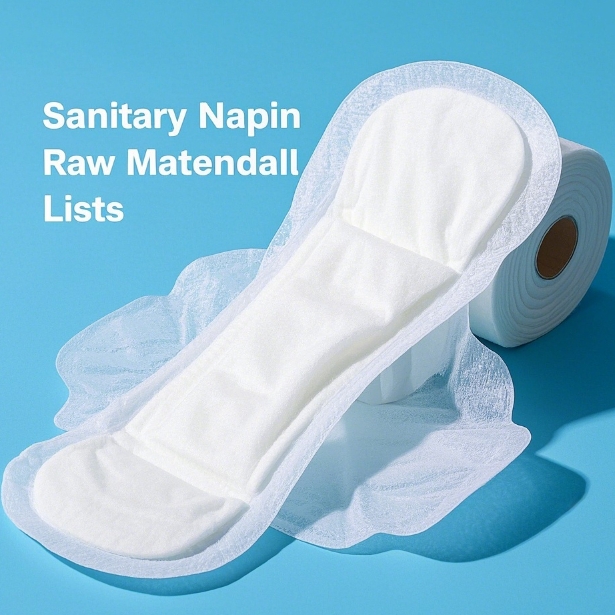For procurement managers, sanitary napkin manufacturers, and nonwoven fabric wholesalers, understanding the precise raw materials used in sanitary napkin production is critical to ensuring product quality, compliance, and end-user satisfaction. This guide breaks down the sanitary napkin raw material list, with a detailed focus on nonwoven fabric types, their properties, and industry-specific terminology tailored to European and North American markets.

1. Core Raw Materials in Sanitary Napkin Production
Sanitary napkins are engineered for absorption, comfort, and hygiene, requiring a blend of specialized materials. Below is the essential raw material list:
- Top Sheet (Cover Stock)
- Material: Nonwoven fabric (spunbond, SMS, or thermal-bonded polypropylene)
- Function: Directly contacts the skin; ensures dryness, softness, and rapid liquid penetration.
- Acquisition Distribution Layer (ADL)
- Material: Airlaid pulp or high-loft nonwoven fabric.
- Function: Distributes liquid evenly to the absorbent core.
- Absorbent Core
- Material: Superabsorbent polymer (SAP) blended with fluff pulp.
- Function: Traps and retains fluid.
- Back Sheet
- Material: Microporous polyethylene (PE) film or breathable nonwoven laminate.
- Function: Prevents leakage while allowing vapor transmission.
- Adhesives
- Material: Hot-melt adhesives (HMAs) for layer bonding; pressure-sensitive adhesives (PSAs) for wing attachment.
- Release Paper & Packaging
- Material: Silicone-coated paper, biodegradable films, or printed polyethylene.
2. Nonwoven Fabric in Sanitary Napkins: Types, Properties & Selection
Nonwoven fabrics dominate sanitary napkin manufacturing due to their cost-efficiency, versatility, and performance. Here’s a breakdown of the most widely used nonwoven types:
A. Spunbond Polypropylene (PP) Nonwoven
- Structure: Thermally bonded continuous polypropylene filaments.
- Advantages:
- High tensile strength and abrasion resistance.
- Hydrophobic surface for quick liquid transfer.
- Breathable and lightweight (15–30 gsm).
- Applications: Top sheet, back sheet, or ADL.
B. SMS Nonwoven (Spunbond-Meltblown-Spunbond Composite)
- Structure: SMS Nonwoven Fabric is A 3-layer composite with meltblown PP sandwiched between spunbond layers.
- Advantages:
- Superior barrier properties (prevents bacterial penetration).
- Enhanced softness and liquid repellency.
- Ideal for premium hygiene products.
- Applications: High-end top sheets or back sheets.
C. Thermal-Bonded (Air-Through) Nonwoven
- Structure: Short fibers (polyester or PP) bonded via hot air.
- Advantages:
- Ultra-soft texture for skin comfort.
- High loft and bulk for improved absorption.
- Applications: ADL or secondary cover stock.
D. Hydroentangled (Spunlace) Nonwoven
- Structure: Mechanically entangled fibers using high-pressure water jets.
- Advantages:
- Cloth-like feel with high absorbency.
- Biodegradable options (e.g., cotton/viscose blends).
- Applications: Eco-friendly or organic sanitary napkins.
3. Why Nonwoven Fabric Selection Matters
Choosing the right nonwoven fabric directly impacts:
- User Comfort: Softness, breathability, and hypoallergenic properties.
- Performance: Liquid strike-through time, rewet resistance, and odor control.
- Sustainability: Recyclable PP or plant-based alternatives align with EU/US eco-regulations.
For procurement specialists, partnering with certified nonwoven suppliers ensures consistency in basis weight, hydrophilicity, and antimicrobial treatments.
Final Tip: Always verify nonwoven fabric certifications (ISO 9001, OEKO-TEX®) and request technical datasheets for pore size, permeability, and tensile strength testing.
